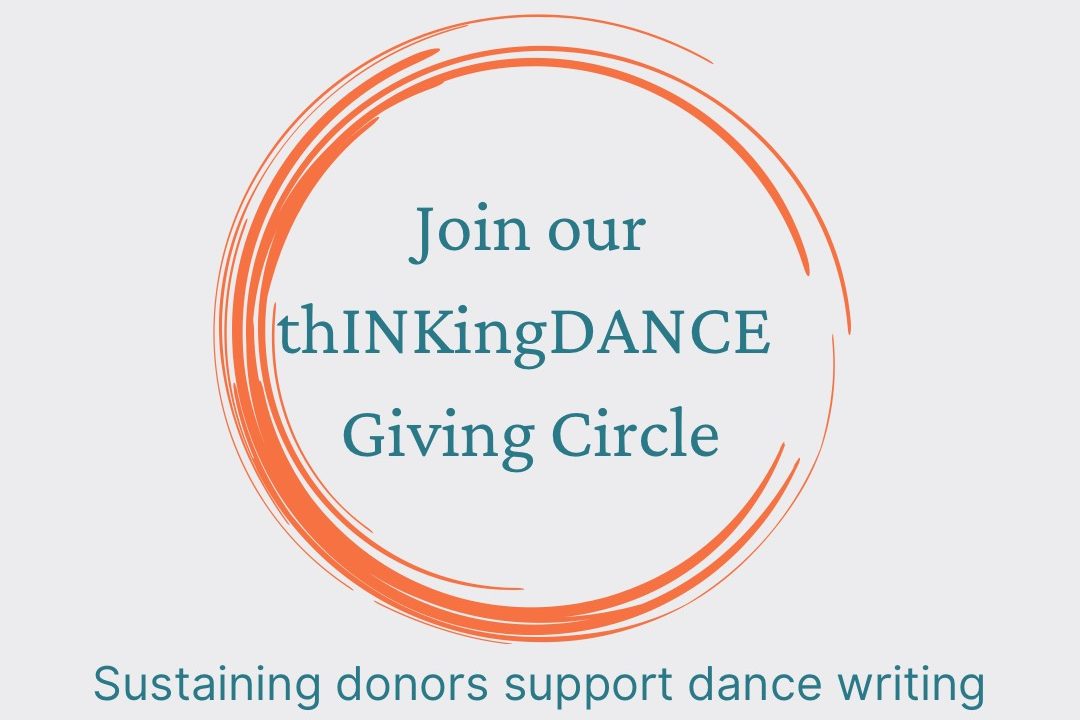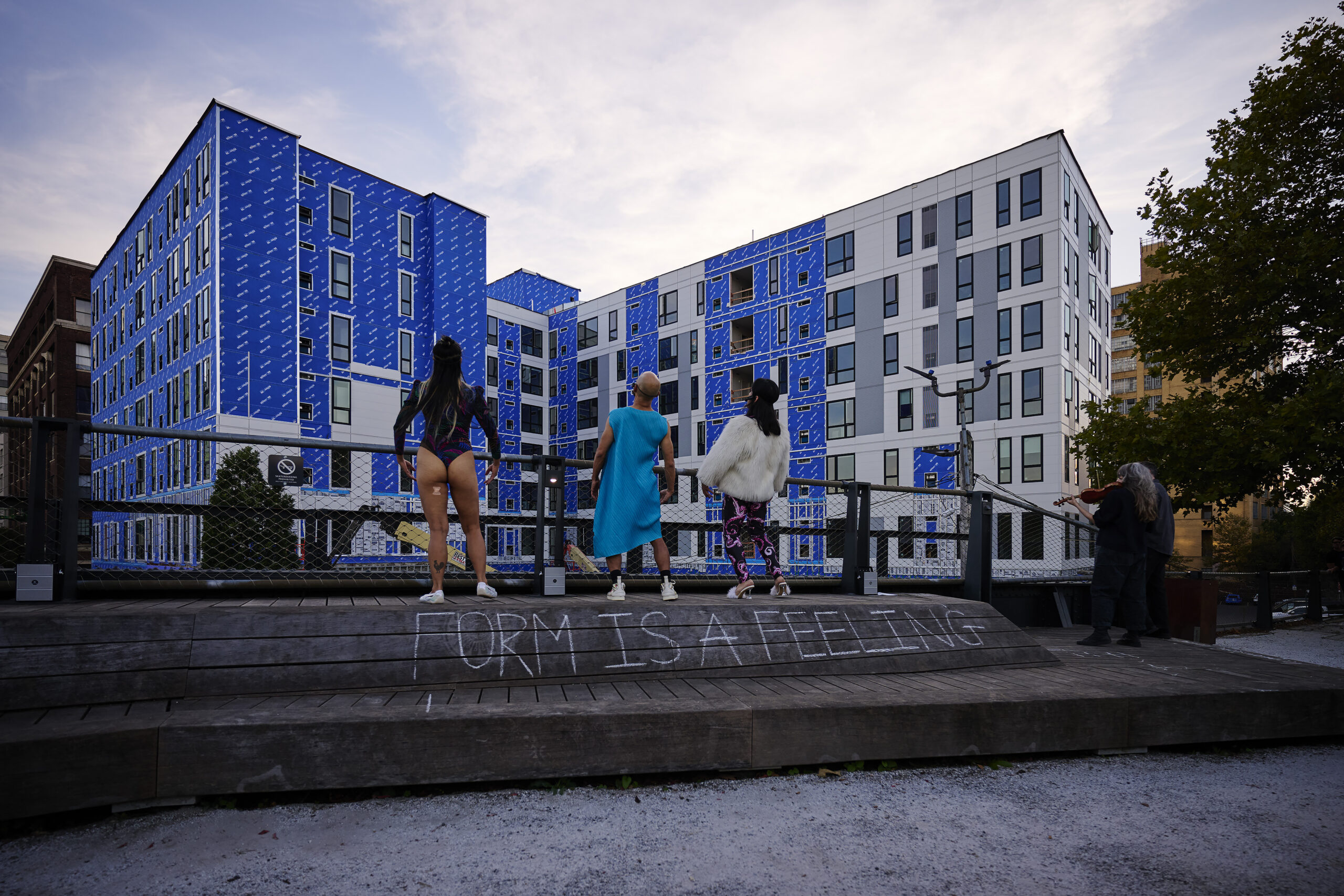“We want a Holocaust Memorial Plaza that’s for all of us, including those of us who are haunted by what we see in Gaza. One that offers a more expansive vision of what Jewish grief can be, that includes mourning and resisting the loss of all the people in Gaza who are being annihilated by the State of Israel. This should be a space for us too.”
-Nicole Bindler, Media Contact
On Friday, September 26th, 2025, Philadelphians and Jews staged a scene from Fiddler on The Roof to disrupt the Philadelphia Holocaust Remembrance Foundation’s Mural Dedication. Their song and dance implored the mural artist and backing organizations to consider another choice.
–
I sit by lush, needly plants and the tangling tower of faceless, bronze limbs in Nathan Rapoport’s 1964 Monument to Six Million Jewish Martyrs. I notice the side street bordering the Holocaust Memorial Plaza is named Israel. A series of plaques contrast American Democracy to Nazi Germany’s Totalitarianism. It feels ironic, given the rise of fascism in the United States right now. Police are present at the event before I arrive.
Rows of folding chairs face the Verizon building, where artist Ella Ponizovsky Bergelson has painted overlapping quotes, stories, and songs in 28 languages.
People greet each other warmly – mostly white people – as they arrive for the dedication of Ponizovsky Bergelson’s Mural, commissioned by Mural Arts Philadelphia (MAP) and the Philadelphia Holocaust Remembrance Foundation (PHRF). A few people are handing out black pamphlets with the mural’s title, Lay-lah Lay-lay (Night Night, Hebrew spelling), and the subtext, “Mural Interpretation Guide” (Sarah, 2025).
Eszter Kutas, the Executive Director of PHRF, follows the pamphlets. “These aren’t part of our program,” she says, and takes them back. She confronts a person handing them out, and attempts, but fails, to pull them from their hands.
Kutas takes the podium. At this moment, I hear music. A klezmer band that reminds me of Bread and Puppet – drums, trumpet, accordion – is processing up the Parkway.
The band is part of a cloud of people wearing white gowns, gauze veils, and faces painted white, with pink around their eyes. They’re dressed like Fruma Sarah, from Fiddler on the Roof, the spirit who implores people to make a choice. They sway-step, holding one arm aloft. They sing “Hashivenu” – a prayer from the Old Testament – as though it’s a funeral opera. The floating ghosts, or harrowed angels, hold three signs:
We are haunted by what’s happening in Gaza.
Never Again is Now.
The Shoah is Now.
“Shoah”, the Mural Interpretation Guide explains, is a Hebrew word, “like the word ‘Nakba’ in Arabic [which] translates to ‘catastrophe.’” While the Mural honors the grief and displacement of Holocaust survivors, it excludes any reference to the present-day Shoah in Gaza, the Guide explains.
The dancing chorus pulls Kutas’ attention. Flustered, she calls Rev Hazzan Glantz up to the podium.
“Ignore them,” he commands. “Avert your eyes rather than give them what they want.”
Yes, the performers are imploring, but what is it they “want”? According to their signs and their songs, they want Philadelphia’s Jewish community to acknowledge Israel’s genocide of Gaza.
The speaker continues with a Hebrew prayer as the dancers hold their palms open, shaking, like pleading to an altar, like a mother wailing “why!” and “please God!” over her child’s dead body. They sing louder as the trumpets and drums pick up speed. The audience is watching. Police and a handful of white men in suits form a wall between the chorus and the attendees. “We are here as your kin,” a dancer speaks out.
The demonstrators sing rewritten lyrics of the song from Tevye’s dream, where Fruma Sarah, the Butcher’s dead wife, warns Tevye against marrying his daughter to her surviving husband.
The song begins:
A blessing on your hearts
(Mazel Tov, Mazel Tov)
To see this work of art
(Mazel Tov, Mazel Tov)
It’s art igniting change
A mural that explains
The genocide in Gaza
Their song lyrics incite a different vision for the mural, one that condemns all genocide and honors all stories of displacement. Their song continues:
For can’t you see, my friends?
(Genocide, Genocide)
You say never again
(Genocide, Genocide)
It’s happening today
With bombs from USA
They call attention to the mural’s erasure of Palestinian displacement and its weaponization of Jewish grief to further justify Israel’s genocide of Gaza.
“The gates of repentance are closing in five days! And when the five days are up–”
They speak of the ten days between Rosh Hashanah and Yom Kippur, which this year are September 22 to October 2, a time to ask for forgiveness and set intentions. If this mural disregards the true values of the High Holidays, there will be consequences, that blank space following “when the five days are up,” seems to warn.
The mural artist takes the podium to share her story, but admits to being distracted. The barricade of police has grown. They’re making a wall with their bikes and pushing the dancers back. Four, maybe five, marshals in neon yellow vests face the police, holding their arms out to the side like cacti, palms open and forward. Photographers and videographers struggle to document as the cops crowd. I see an officer shove a photographer. I see a cop with his hand on his holstered shotgun.
The chorus never breaks its sorrowful melody. Officer after officer after officer arrives. They ask me to move to the side. “Am I in the way?” You’re behind the line of police, they explain, and that’s a problem. Even at a 15 ft distance.
The tambourine shimmers as the drum slowly beats. By now, the wall of cops, and their bikes, and their men in suits, have pushed the performers to the edge of the mural wall. By now, there may be as many cops as there are performers.
The dancer’s eyes are heavy with the weight of their ominous song. Some singers close their eyes to open their mouths wider. They hold their palms open once more. This time, like they’re giving a sermon, as they slowly sway backward. When they reach 17th street, they cross Arch and disappear. I count at least 15 police cars, trucks, and vans, some unmarked, lining Arch Street.
As the singing fades, I return my attention to the event speakers. “In spite of the darkness, she has brought us light,” Jane Gordon says of the artist, “beckoning us toward a more just world.”
Lindsey Rosenberg, project management consultant, thanks a long list of funders, which include, as the Mural Interpretation Guide states, “Holocaust Remembrance Foundation’s Zionist funders, Alan Horwitz and David Adelman… [who are also] the founder and CEO of Campus Apartments, the country’s largest privately held student housing company, and a major driver of gentrification in West Philadelphia.”
This mural is the culmination of five public events in which over 100 people participated, Rosenberg explains. At one such community meeting in January, Nicole Bindler recounts, the funders publicly pressured the artist not to mention Palestine, warning her to remember who’s paying for the mural.
Rosenberg goes on to praise artist Ponizovsky Bergelson for holding “many truths together” at the same time. Yet a key truth is missing: Palestine.
Kutas returns to the podium to share her story of a Hungarian folk song passed down through her family despite the Holocaust. Her story is not unique, she tells us; people all over the world share stories of displacement. This is what the mural is about, she declares. She never mentions Gaza, where Israel has displaced many millions since the Nakba in 1947, and massacred 66,000 Palestinians since October 7th, 2023. “This number of identified bodies is certainly an undercount. Untold thousands lie unrecovered under the rubble in Gaza” (Mural Interpretation Guide).
Rav Hazzan Glantz closes with a Hebrew prayer of gratitude, everyone sings and claps, much like the ghosts of Fruma Sarah did minutes before.
I leave asking, what singing is sanctioned? Whose prayer is allowed? Public art has the power to uplift, honor, and reflect people’s survival and humanity. But in the case of Lah-Lay Lah-Lay, Zionist funders have stripped this power. Instead, Lah-Lay Lah-Lay erases Palestinian life, death, and displacement. So it is no surprise that the performance of Jews and Philadelphians who deplore this genocide is also suppressed by the state.
I almost want to ask, since when is singing and dancing and praying in public a reason to call the police? But the answer is, since always. Because resisting colonial power, with art or otherwise, has always been unsanctioned. Amidst the rise of facism in the US and globally, not even whiteness is a protection when people denounce colonization with their bodies.
I wonder what the attendees recall from this dedication day? What rings louder? The words of the speakers or the haunting song of Fruma Sarah? I wonder also, is there a possibility for these artists to be in conversation? For Ponizovsky Bergelson to augment her mural, to paint in the words of Palestinians. You are responsible, Fruma Sarah says to the mural’s artist, funders, organizational backers, and dedication attendees – so do something, or be haunted.






